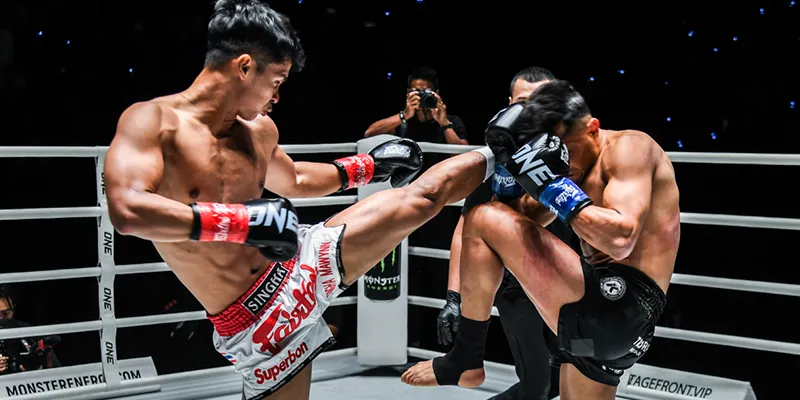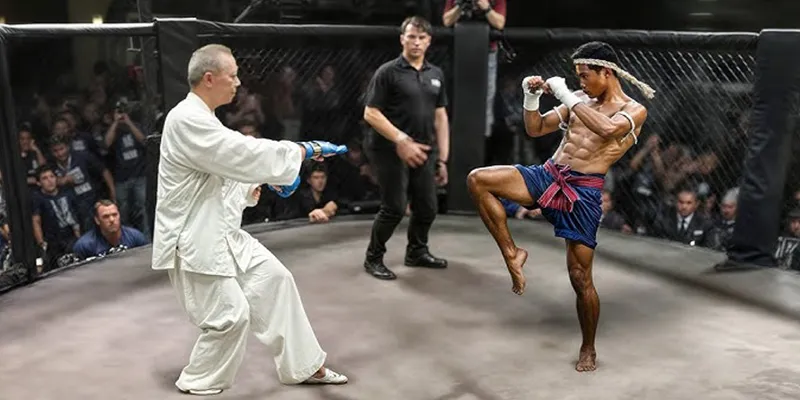Is Tai Chi the Same as Kickboxing? The direct answer is NO, Tai Chi and kickboxing are kindly different, despite both being “martial arts.” This confusion often arises because some modern fitness programs might even blend them, further muddying the waters. However, their philosophies, training methods, and ultimate goals are completely different.

Tai Chi is an ancient Chinese internal martial art rooted in Taoist philosophy, with slow, deliberate movements, Qi cultivation, and harmonious integration of mind and body. Kickboxing, conversely, is a modern, external combat sport derived from the synthesis of Western boxing and Asian kicking techniques, prioritizing speed, power, explosive athleticism, and competitive engagement. This article will show their uniqueness, compare their core differences, and provide clear guidance on selecting the practice with your personal objectives.
What Is Tai Chi?
Tai Chi, known as Taijiquan, is more than mere physical exercise; it is a comprehensive mind-body practice deeply embedded in Chinese culture, philosophy, and traditional medicine. Originating centuries ago, its development is often attributed to figures like Chen Wangting in the Chen Village, evolving into distinct family styles (Chen, Yang, Wu, Sun, and Wu/Hao).

At its core, Tai Chi is an internal martial art, meaning its power generation and effectiveness are not primarily from muscular strength but from the cultivation and conscious direction of internal energy, precise body structure, relaxed yet alert posture, and the sophisticated mechanics of spiraling force.
Tai Chi practitioners learn sequences of movements called “forms,” executed with mindful slowness, fluidity, and continuity. Each posture flows seamlessly into the next, embodying the Taoist principles of Yin and Yang—the complementary opposites found in nature. While the slow practice is most visible and forms the foundation for health benefits, Tai Chi also contains martial applications practiced through partner drills like Push Hands, which develop sensitivity, balance disruption, and redirecting an opponent’s force.
The health benefits, such as improved balance, reduced stress, enhanced joint mobility, cardiovascular health support, and heightened body awareness, are inseparable from its martial roots and philosophical depth, making it often described as “meditation in motion.”
What Is Kickboxing?
Kickboxing is a dynamic, high-intensity stand-up combat sport born in the mid-20th century from the cross-pollination of techniques primarily drawn from Western boxing (jabs, crosses, hooks, and uppercuts) and various traditional striking arts like karate, Muay Thai, and savate (kicks: front kicks, roundhouse kicks, side kicks, and sometimes knee strikes, depending on the rule set).

Unlike Tai Chi’s internal focus, kickboxing is distinctly external, relying on physical attributes like speed, power, strength, agility, endurance, and sharp reflexes. Training is rigorous and athletic, typically involving heavy bag work, focus mitt/pad drills with a trainer, skipping rope for footwork and cardio, core strengthening, sparring, and conditioning exercises.
The primary purposes are clear: to develop effective offensive and defensive striking skills for self-defense scenarios and to compete effectively within the sport’s rules. Kickboxing provides an exceptional full-body cardiovascular workout, significantly improves muscular strength and endurance, particularly in the core, legs, and shoulders, enhances coordination, timing, and spatial awareness, and builds mental toughness and confidence through overcoming physical challenges and sparring.
Kickboxing is a demanding sport where intensity, power generation, and strategic application of force under pressure are paramount.
Tai Chi vs Kickboxing: Difference
The difference between Tai Chi and kickboxing has multiple dimensions.

Philosophically, Tai Chi is rooted in Taoist principles, seeking harmony, balance, and the cultivation of internal energy. It emphasizes yielding, softness overcoming hardness, and resolving conflict with minimal force. Kickboxing operates on principles of athletic competition, efficiency of force, dominance, and overcoming an opponent through superior speed, power, and technique within a rule-based framework.
Their movement features are opposed: Tai Chi is deliberate, slow-motion flow, maintaining continuous, grounded connection and deep, relaxed breathing. Kickboxing movements are explosive, fast-twitch, and high-impact, involving rapid bursts of energy, sharp retractions, and dynamic footwork, often accompanied by forceful exhalations during strikes.
The primary purpose differs significantly; while both can be used for self-defense, Tai Chi is primarily practiced today as a holistic health art and moving meditation, promoting longevity, stress reduction, and deep internal awareness. Kickboxing is a combat sport and intense fitness regime focused on developing fighting proficiency, athletic performance, and physical conditioning. Intensity levels reflect this: Tai Chi practice is low-impact and generally low-to-moderate intensity, accessible to almost all ages and fitness levels. Kickboxing training is high-impact, high-intensity, demanding peak physical exertion and carrying a higher inherent risk of acute injury.
Tai Chi is a unique internal awareness of energy flow and structural alignment, while kickboxing hones external attributes like reaction time, power generation, and tactical fight IQ. Tai Chi learning is often a slow, deep refinement over years or decades, while kickboxing offers more immediate physical feedback and practical skill.
Tai Chi or Kickboxing: How to Choose?
Selecting between Tai Chi and kickboxing depends on your personal goals, physical condition, temperament, and philosophical alignment.

Choose Tai Chi if your primary goals are stress reduction, improving balance and preventing falls, enhancing joint flexibility and mobility, cultivating mindfulness and deep body awareness, seeking a gentle yet profound practice for longevity and holistic health, or exploring the philosophical and energetic aspects of martial arts. Its low-impact nature makes it exceptionally suitable for individuals with joint issues, chronic pain, or those recovering from injury, as well as anyone seeking a calming counterbalance to a hectic modern life.
Choose kickboxing if your goals are centered on achieving high-intensity cardiovascular fitness, building significant muscular strength and endurance, learning practical self-defense skills, developing confidence through overcoming physical challenges, enjoying the structure and adrenaline of a competitive sport, or simply wanting a powerful outlet for releasing stress through intense physical exertion.
It’s ideal for those with a good baseline fitness level who enjoy dynamic, fast-paced activities and aren’t averse to physical contact or higher impact.
Crucially, tai chi and kickboxing are not mutually exclusive. Many practitioners find immense value in combining them. Kickboxing provides the intense physical outlet and practical combative skills, while Tai Chi offers deep recovery, balance enhancement, injury prevention through improved body mechanics, and a powerful tool for mental centering and stress management, creating a well-rounded physical and mental regimen.
Before committing, research reputable schools and instructors in both disciplines, attend introductory classes to experience the atmosphere and teaching style firsthand, and be honest with yourself about your motivations and physical capabilities.
Summary
Tai Chi is slow, mindful, and meditative, prioritizing harmony, Qi flow, structural integrity, and lifelong health. Kickboxing is fast, powerful, and explosive, emphasizing athleticism, physical dominance, tactical combat, and high-intensity conditioning. The key differences lie in their philosophy, movement quality, primary focus, and intensity. Ultimately, the choice isn’t about which art is “better,” but which path—or which combination of paths—best resonates with your body, your mind, and your aspirations for personal growth.


